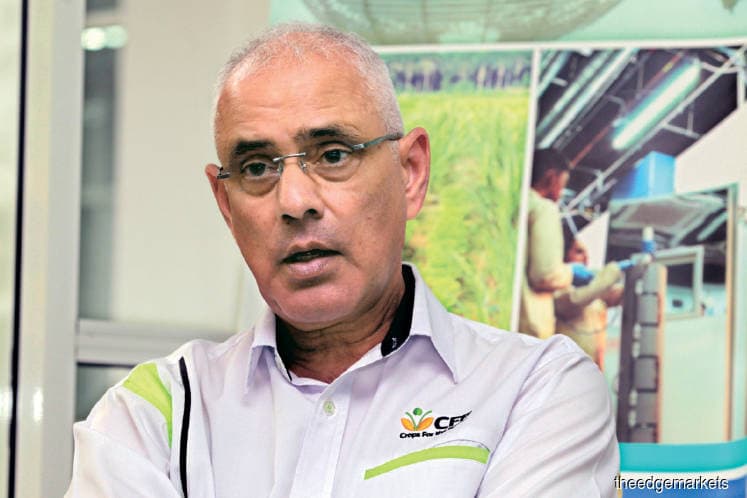
This article first appeared in The Edge Malaysia Weekly on November 11, 2019 - November 17, 2019
THE agricultural sector contributed 8.2% or RM96 billion to Malaysia’s gross domestic product in 2017. Palm oil was the major contributor at 46.6% followed by other agriculture produce (18.6%), livestock (11.4%), fishing (10.5%), rubber (7.3%) and forestry and logging (5.6%).
Education and Research Association for Consumers Malaysia’s (ERA Consumer) report “Situation of Agriculture in Malaysia: A Cause For Concern” says the second National Agricultural Policy 1992-2010 (NAP 2) stressed that the agriculture sector should be market-led, commercialised, efficient and competitive.
“Food crops were therefore neglected and concentration in the agricultural sector was on commodities like palm oil, cocoa and rubber, which besides being of export value, were also important to the local manufacturing sector,” the report says.
Council of Eminent Persons chairperson and former finance minister Tun Daim Zainuddin, who has been vocal on the agriculture sector of late, says Malaysia needs to pay more attention to its agri-food sector.
“Not much of our agriculture is agro-food. Most of our agribusiness is palm oil, some rubber, pepper and gambier. There was a reason for this — they were good business and we were excellent in producing these commodities.
“However, now prices have slumped and we need to diversify. For instance, in Indonesia, they now plant corn in between their palm oil crops. By deploying agricultural instructors, they have reduced their import of corn from 3.6 million tonnes to 180,000 tonnes. It does not have to be a clear demarcation between agribusiness and agro-food. Those in the plantation business can look at innovative ways to improve food security,” Daim tells The Edge in an email response.
The scarcity of agricultural land is often cited as one of the main reasons food security is an issue in Malaysia, with a reported 86% of agricultural land used for production of industrial commodities while only 14% is set aside for agrofood commodities.
“There is plenty of agricultural land available, but there are many hoops to jump through to gain access to it. Furthermore, a very small proportion of our land is arable, that is, land that has been tilled and is ready for the planting of seasonal crops.
“There is also plenty of idle land … about 119,000ha of agricultural land is currently idle. The Department of Agriculture now has initiatives to promote the development of idle land. I would encourage farmers and budding farmers to look into these initiatives and take advantage of them while they are still being offered,” says Daim.
It is worth noting that the government announced in Budget 2020 that RM150 million will be allocated to facilitate crop integration for farmers, to help supplement their income such as through the planting of chilli, pineapple, coconut, watermelon and bamboo.
“The private sector and the government need to work together to make agro-food more profitable. We need more efficient harvesting methods, processing, manufacturing and storage technology.
“We do not need to reinvent the wheel. We can look at our neighbours to see how they are making the most of the land available, as well as open up opportunities for local groups to innovate and make use of our land banks,” says Daim.
Looking at alternative crops
Prof Sayed Azam-Ali, CEO of the world’s first and only centre for alternative crops, Crops for the Future Research Centre (CFFRC), says Malaysia needs to look at its comparative advantage, which is biodiversity.
“Malaysia shouldn’t ignore that because when you look at other countries that have zero biodiversity but are big on agriculture, such as Denmark, it really is a missed opportunity for Malaysia.
“It is not right to think of agriculture as a sunset industry for Malaysia … we need a recalibration. We understand that Malaysia is very keen on cash crops, but there are other ways to obtain income by innovating your crops to make high-value products,” he tells The Edge in a recent interview.
CFFRC does research on underutilised crops and two crops that it has been looking at in Malaysia are Moringa Oleifera, which is often called the drumstick tree, and kacang poi, or Bambara groundnuts.
“Moringa leaves are packed with nutrients — zinc, selenium, iron, calcium and vitamins. We are working with a community in Petaling Jaya to collect the leaves from different households — we dry the leaves to make flour, from which you can make products such as cookies and snacks. When they fall to the ground, Moringa flowers add nitrogen to the soil and the stems can be used for biomass to make energy,” says Sayed.
“Kacang poi or Bambara groundnuts are grown in Perlis and Kedah on a very small scale. They are nutritious and contain a high amount of protein. If you process them into flour, you have a replacement for imported soy and wheat flour and maize to feed chickens.
“A huge portion of poultry and animal feedstock depend on maize and soy imports, and we can replace them with crops that we can grow here, such as kacang poi and Moringa, on land that is not suitable for big crops, and we have got an income-generating opportunity for farmers,” he adds.
Sayed says the government needs to look at incentivising, and not subsidising farmers, by providing them with a marketplace for these new crops, as well as the technological know-how to value-add to the crops.
Save by subscribing to us for your print and/or digital copy.
P/S: The Edge is also available on Apple's AppStore and Androids' Google Play.